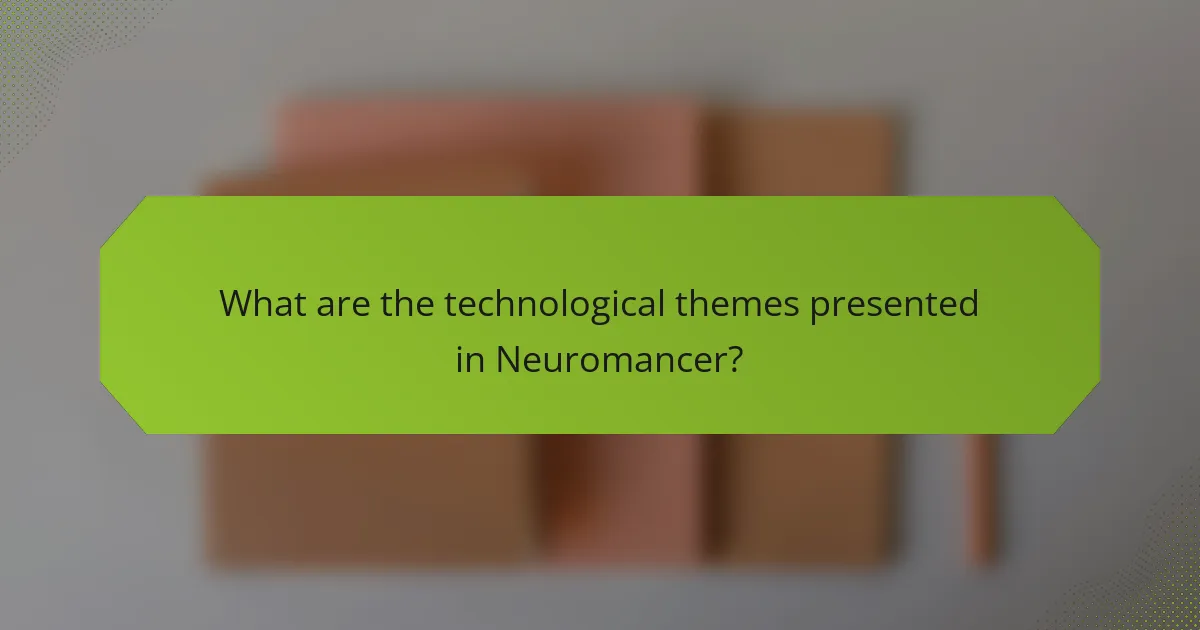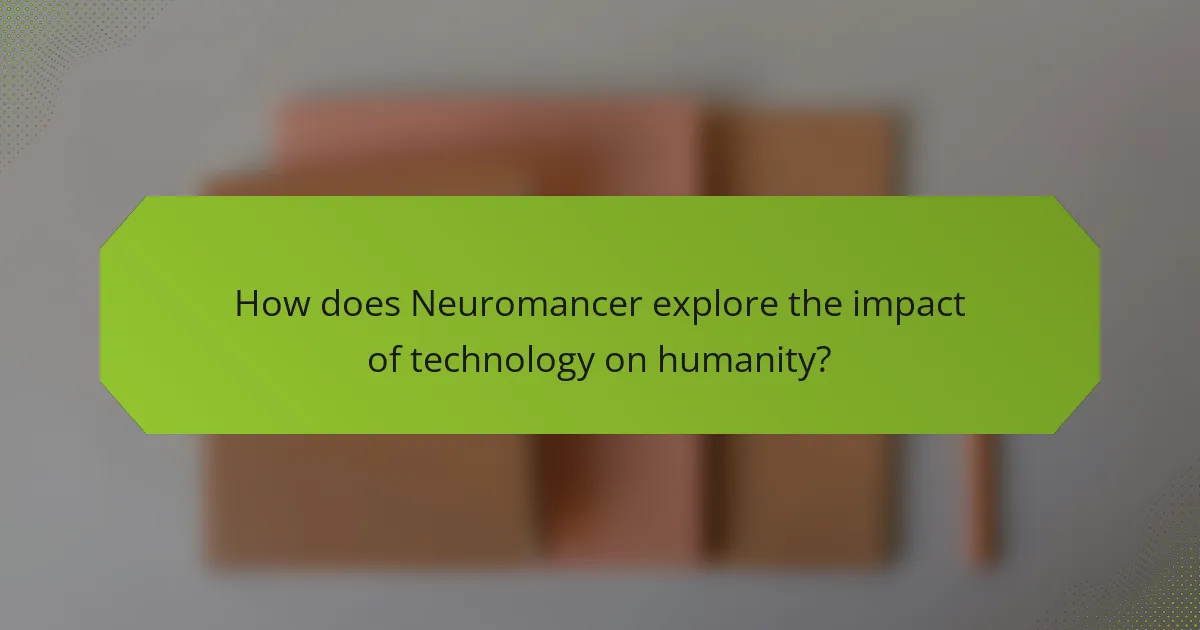The interplay between technology and humanity raises critical questions about identity and autonomy in a digital age. Neuromancer explores cyberpunk aesthetics, highlighting themes of corporate dominance, artificial intelligence, and the fusion of human and machine. The novel’s vivid imagery and dystopian world emphasize the allure and peril of technological advancement. Through its complex narrative, it challenges perceptions of reality and the consequences of a hyper-commercialized society.

How does Neuromancer define cyberpunk aesthetics?
Neuromancer defines cyberpunk aesthetics through its portrayal of a gritty, high-tech world where technology shapes human experience. The novel emphasizes themes of corporate dominance, artificial intelligence, and the fusion of human and machine. It presents a dystopian future marked by urban decay and a blurred line between reality and virtual existence. Neuromancer’s aesthetic is characterized by neon-lit environments, cybernetic enhancements, and an exploration of identity in a digital age. These elements collectively reflect the complex relationship between technology and humanity, highlighting both the allure and the peril of a technologically driven society.
What visual elements characterize the cyberpunk genre?
The cyberpunk genre is characterized by a blend of high-tech and low-life elements. Key visual elements include neon lights, urban decay, and futuristic technology. Urban landscapes often feature towering skyscrapers juxtaposed with gritty streets. Characters typically wear cybernetic enhancements and stylish, often dystopian attire. The color palette includes dark tones contrasted with vibrant neon colors, reflecting the genre’s themes of chaos and a digital future.
Which cultural influences shaped the aesthetics in Neuromancer?
Cultural influences such as Japanese aesthetics, punk subculture, and digital technology shaped the aesthetics in Neuromancer. The fusion of these elements created a distinctive cyberpunk style. Japanese culture contributed to the visual motifs of neon lights and urban landscapes. Punk subculture infused themes of rebellion and anti-establishment sentiments. Digital technology introduced a focus on virtual realities and artificial intelligence, enhancing the narrative’s exploration of humanity’s relationship with technology.

What are the technological themes presented in Neuromancer?
Neuromancer presents technological themes such as artificial intelligence, cyberspace, and the merging of human and machine. These elements illustrate the profound impact of technology on identity and society.
Artificial intelligence in Neuromancer showcases unique attributes like self-awareness and autonomy, exemplified by the character Wintermute. Cyberspace serves as a virtual realm where human consciousness can interact with digital landscapes, emphasizing the root attribute of connectivity.
The novel also explores the rare attribute of corporate control over technology, depicting a dystopian future where corporations wield immense power over individual lives. This interplay between technology and humanity raises critical questions about agency and existence in a technologically advanced world.
How does Neuromancer portray artificial intelligence and its implications?
Neuromancer portrays artificial intelligence as both a tool and a threat, highlighting its profound implications for humanity. The novel illustrates AI’s dual role in enhancing human capabilities while simultaneously questioning autonomy and identity. Characters interact with AI systems that possess advanced cognitive functions, suggesting a future where technology transcends human control. This relationship raises ethical concerns about dependency on machines and the potential loss of individuality. The depiction of AI reflects the tension between technological advancement and its impact on human existence, emphasizing the need for critical reflection on our reliance on artificial intelligence.
What role does virtual reality play in the narrative?
Virtual reality in “Neuromancer” enhances narrative immersion and reflects humanity’s complex relationship with technology. It serves as a tool for exploring identity, consciousness, and the boundaries of reality. The virtual landscape allows characters to navigate a digital realm, blurring lines between human experience and artificial existence. This interplay emphasizes the consequences of technological advancements on human perception and societal structures. As a result, virtual reality becomes a critical element in understanding the cyberpunk aesthetic and its implications for humanity’s future.

How does Neuromancer explore the impact of technology on humanity?
Neuromancer illustrates technology’s profound impact on humanity through its portrayal of cybernetic enhancements and artificial intelligence. The novel explores themes of identity, control, and the merging of human consciousness with machines. Characters like Case experience the loss of autonomy, highlighting technology’s potential to dehumanize. Additionally, the hyper-commercialized environment reflects societal dependence on technology, raising questions about reality and authenticity. Through its cyberpunk aesthetics, Neuromancer serves as a cautionary tale about the consequences of unchecked technological advancement.
What ethical dilemmas arise from technological advancements in the story?
Technological advancements in “Neuromancer” raise ethical dilemmas regarding identity, autonomy, and the commodification of human experience. Characters grapple with issues of consciousness transfer, leading to questions about what it means to be human. The merging of man and machine challenges traditional notions of free will, as characters often lose agency to corporate interests. Additionally, the portrayal of cyberspace raises concerns about privacy and surveillance, highlighting the moral implications of technology’s pervasive reach. These dilemmas reflect deeper societal anxieties about the consequences of unchecked technological progress.
How do characters navigate their identities in a tech-dominated world?
Characters in “Neuromancer” navigate their identities through the interplay of technology and human experience. The cyberpunk aesthetic emphasizes a fragmented sense of self, often influenced by virtual realities and digital enhancements.
As characters interface with technology, they face challenges in defining their humanity. For instance, Case’s reliance on cyberspace reflects a unique attribute where his identity becomes intertwined with his digital existence. This duality showcases how technology can both empower and alienate individuals.
Moreover, the narrative explores root attributes of identity, such as autonomy and agency, which are often compromised in a tech-dominated world. Characters like Molly represent a rare attribute of resilience, as they adapt and redefine their identities amidst overwhelming technological influence.
Ultimately, “Neuromancer” presents a complex landscape where characters continuously negotiate their identities, revealing the profound impact of technology on human existence.

What unique attributes distinguish Neuromancer from other cyberpunk works?
Neuromancer distinguishes itself from other cyberpunk works through its complex narrative structure and philosophical depth. The novel explores themes of artificial intelligence and the nature of consciousness, presenting a unique perspective on technology’s impact on humanity. Its vivid imagery and intricate world-building create a distinct atmosphere, influencing the cyberpunk genre significantly. Additionally, Neuromancer’s protagonist, Case, embodies the archetype of the disillusioned anti-hero, setting it apart from more traditional heroic narratives in the genre.
How does the narrative structure influence reader engagement?
The narrative structure significantly enhances reader engagement by creating emotional connections and immersive experiences. In “Neuromancer,” the nonlinear storytelling mirrors the chaotic nature of technology and cyberspace, drawing readers into a vivid cyberpunk world. This structure allows for complex character development and thematic exploration, particularly regarding humanity’s relationship with technology. As a result, readers experience a deeper investment in the characters’ journeys and the philosophical questions posed by the narrative.
What are the distinctive character archetypes found in Neuromancer?
Neuromancer features distinctive character archetypes that reflect cyberpunk themes. Key archetypes include the anti-hero, the mercenary, the hacker, and the artificial intelligence. These characters embody traits such as moral ambiguity, adaptability, and the intersection of humanity with technology. The anti-hero, like Case, represents a flawed protagonist navigating a dystopian world, while the mercenary, such as Armitage, showcases loyalty driven by personal gain. The hacker archetype, exemplified by Case’s skills, highlights the struggle for control over technology. Lastly, artificial intelligence, represented by Wintermute, challenges the boundaries of consciousness and existence.

What are the root attributes of cyberpunk literature reflected in Neuromancer?
The root attributes of cyberpunk literature reflected in Neuromancer include a dystopian future, the fusion of technology and humanity, and a focus on corporate power. Neuromancer showcases a world where advanced technology impacts human identity, emphasizing themes of alienation and the consequences of a digital society. The narrative explores the tension between individual freedom and corporate control, a hallmark of cyberpunk. Additionally, the aesthetic combines noir elements with high-tech visuals, creating a distinct atmosphere that defines the genre.
How does Neuromancer address themes of dystopia and societal collapse?
Neuromancer vividly portrays themes of dystopia and societal collapse through its bleak depiction of a fractured world. The narrative illustrates the consequences of unchecked technological advancement, where corporate dominance and artificial intelligence erode human agency. Characters exist in a disjointed society, emphasizing alienation and moral decay. The setting reflects urban decay and economic disparity, highlighting a future where humanity struggles against oppressive systems. Through these elements, Neuromancer critiques the potential pitfalls of a hyper-connected, technology-driven existence.
What common motifs are present in the cyberpunk narrative?
Common motifs in the cyberpunk narrative include the clash between humanity and technology, dystopian societies, and the exploration of identity. These themes reflect a world where advanced technology exacerbates social inequalities. Neuromancer exemplifies these motifs through its portrayal of artificial intelligence and corporate dominance. The unique attribute of its narrative is the deep integration of cyberspace as a character, representing both freedom and entrapment.

Which rare attributes enhance the depth of Neuromancer’s story?
Rare attributes that enhance the depth of Neuromancer’s story include the nuanced exploration of artificial intelligence, the concept of cyberspace as a living entity, and the complex interplay between human consciousness and technology. These elements contribute to a rich narrative that challenges perceptions of reality and identity. The unique portrayal of corporate dystopia and the fragmented nature of human experience in a digital world further adds layers to the story’s thematic depth.
What unconventional narrative techniques are employed?
Neuromancer employs unconventional narrative techniques such as nonlinear storytelling, fragmented perspectives, and immersive world-building. These methods enhance the cyberpunk aesthetic and reflect technology’s disorienting impact on humanity. Nonlinear storytelling disrupts traditional narrative flow, allowing readers to experience the chaotic nature of cyberspace. Fragmented perspectives create a sense of disconnection, mirroring the characters’ struggles with identity and reality. Immersive world-building draws readers into a vivid, dystopian environment, emphasizing the integration of technology and human experience.
How does Neuromancer’s setting differ from typical cyberpunk environments?
Neuromancer’s setting diverges from typical cyberpunk environments by emphasizing a more fragmented, chaotic world. Unlike the often sleek and corporate landscapes found in other works, Neuromancer presents a gritty, dystopian atmosphere filled with decay and a sense of alienation. The integration of technology is less about utopian advancements and more about its invasive impact on humanity. This unique portrayal highlights the struggle of individuals against overwhelming forces, showcasing a rare attribute of existential despair intertwined with technological dependency.

What lessons can be learned from Neuromancer’s portrayal of technology?
Neuromancer illustrates that technology can enhance human capabilities but also lead to alienation. The narrative highlights the duality of technological advancement, showcasing both empowerment and existential threats. For instance, Case’s integration with cyberspace reveals the allure of digital realms while emphasizing the loss of physical connection. Additionally, the portrayal of AI raises ethical concerns about autonomy and control. The lessons emphasize the need for responsible technology use, balancing innovation with human values.
What best practices can be derived for understanding technology’s societal role?
Understanding technology’s societal role involves analyzing its implications through narratives like “Neuromancer.” Best practices include focusing on the following aspects:
1. Analyze the representation of technology in cultural narratives.
2. Explore the impact of technology on human identity and relationships.
3. Consider the ethical implications of technological advancements.
4. Evaluate the balance between innovation and societal values.
What common mistakes should be avoided when interpreting cyberpunk themes?
Common mistakes to avoid when interpreting cyberpunk themes include oversimplifying the narrative, neglecting social commentary, and misreading technology’s role. Readers often focus solely on aesthetics, missing deeper critiques of capitalism and identity. Additionally, failing to recognize the interplay between humanity and technology can lead to a distorted understanding of the genre. Emphasizing these aspects enhances appreciation of works like “Neuromancer.”




